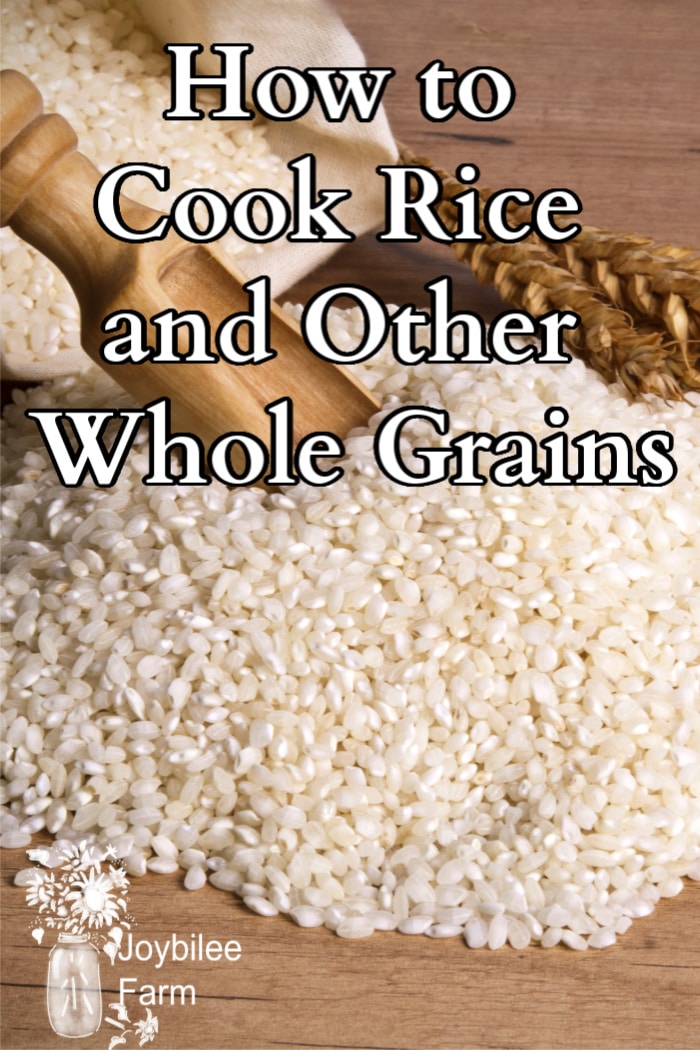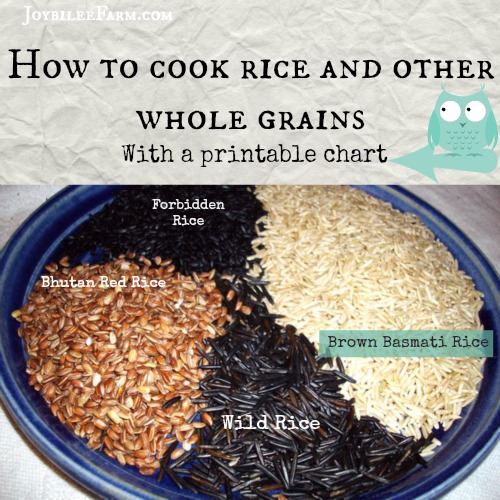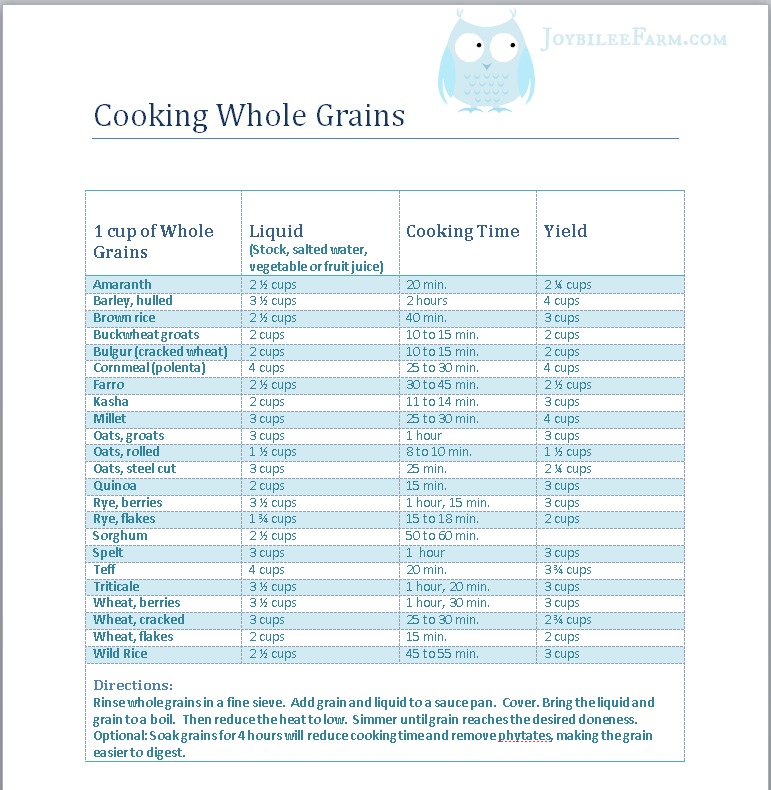Learn how to cook rice and other grains and be a master of cooking from whole grains. Add these useful, shelf stable staples to your diet without specialized equipment or a huge time investment.
How to cook rice and other whole grains
Along with those beans, we talked about last week, maybe you’ve got rice and other whole grains in your food storage. If you don’t have a clue how to use whole grains in a meal this post will help.
For long term storage, more than just a month or two, it’s better to store grains as whole grains rather than flour or groats because whole grains are less likely to go rancid than milled whole grain flours or flaked grains.
Whole grains are versatile
They can be milled into flour. They can be used in baking or cooked like rice, as a side dish or turn them into a salad. You can use them for breakfast cereal or make a pudding with them for dessert. Provided you know how to cook rice you can easily master any whole grain. But there are no hard rules that apply to all grains, when it comes to how to cook them and use them. These tips will remove some of the confusion.
How to cook rice
While white rice isn’t a whole grain, learning how to cook rice will help you figure out how to cook other whole grains. Forget the idea of putting the rice in a pot, adding water, boiling and then draining away the excess water. You lose a lot of flavour and nutrition that way. Here’s my fool proof method to cook white rice:
- Rinse the rice in a seive under cold running water, to remove excess starch.
- Put 1 1/2 cups of water, 1/2 tsp. of Himalayan salt, and 1 cup of white rice in a covered sauce pan.
- Bring the rice to a boil.
- Turn the heat down and simmer the rice for 10 to 15 minutes.
- The rice will absorb all the liquid in the pan. Turn off the heat.
- Allow the rice to steam for an additional 10 minutes.
- Fluff the rice with a fork to separate the grains.
Other kinds of rice cook at different rates and will absorb a different amount of water. The package directions will give you guidance as to how much water to use per cup of rice. For instance, brown rice takes 40 minutes to cook and needs 2 cups of water. I use the same ratio when I cook Forbidden Rice or Bhutan Red Rice, two of my favorites. Soaking your rice for a few hours before cooking will speed up the cooking time.

Parboiled rice is whole grain brown rice that is pre-cooked and then dried. It will cook faster than regular brown rice. Short grain rice gives a creamy rice suitable for traditional rissoto or rice pudding. Long grain rice like basmati rice is best when each grain is separated in the dish. You can increase the creaminess of short grain rice by stirring the rice as it cooks, to release more starch. Likewise the grains of long grain rice can be kept separate by reducing the amount of stirring and allowing the grains of rice to steam and plump unaided.
What are whole grains?
Whole grains, like brown rice, are grains that contain all the parts of the grain including the oil and the germ portion. Some whole grains, like wheat and rye berries avoid rancidity by being kept in the whole form, in storage. Other whole grains like brown rice, rapidly lose their freshness if kept in storage for a long time and need special treatment, like vacuum sealing with oxygen absorbers, to stay fresh longer.
Whole grains contain more vitamins, and minerals than their fractionated counterparts.
Which Whole Grains are gluten free?
One advantage of using whole grains is that some are naturally gluten free. When you have these in your food storage, you can mill your own flour, without concern for food allergies or sensitivities to gluten. The gluten grains are wheat, rye, and barley. Grains of the wheat family like triticale, spelt, farro, duram, and kamut will also have gluten. Other grains like oats may have traces of gluten if they are stored or processed at a mill that also processes wheat, rye, or barley. So if you need to keep your grains gluten free, chose grains that are certified gluten free from a mill that doesn’t process wheat, rye, or barley.
Creative Ways with Whole Grains
I recently enrolled in a free Craftsy course taught by Anna Bullet, executive chef of Cooking Light. (I’m an affiliate for Craftsy) Since the class was free I expected a mini class without much meat. Boy was I wrong. The class has 5 modules that explores actual recipes that use unusual whole grains in new ways. If you are feeling nervous about trying those wheat berries or quinoa in your food storage, this class is an easy introduction. Anna talks about where to get some of the unusual ingredients for the recipes. All recipes are downloadable and printable.
After you’ve made wild rice and brown rice pilaf or farro rissoto with mushrooms, you’ll have the confidence to get creative with whole grains. Anna is upbeat and cheerful. There is a discussion group as part of the class where you can see what other class mates have come up with. And did I mention the class is free, so there’s no reason to hesitate. I watched the entire class on a Sunday afternoon. Even though I’ve been cooking with whole grains for decades, I learned a few things and gained some tips.
You can sign up for the free class — HERE.
How to cook whole grains
Print this chart to help you keep track of how to cook different kinds of whole grains.
Some ways to serve Whole Grains
Gluten free cereal with figs and almond butter
Chai Spiced Whey Rice Pudding from Homespun Seasonal Living
Gluten-free Raw Buckwheat Granola Recipe from Homestead Honey
Squash Millet Bake from Homespun Seasonal Living
Fresh Spanish Rice from Reformation Acres
Your turn:
What’s your favorite way to showcase whole grains or rice at your family meals?






Leave a Reply